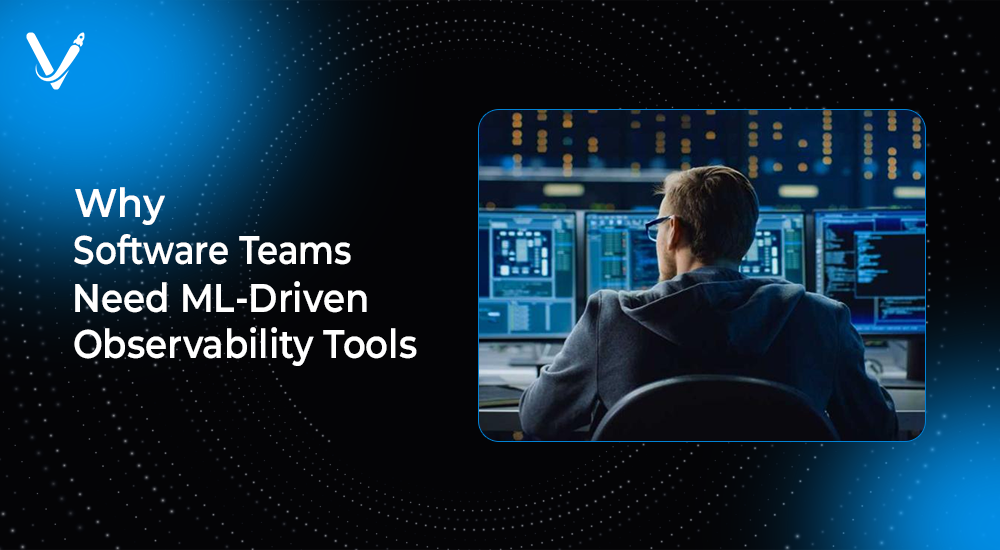Why Software Teams Need ML-Driven Observability Tools


- Oct 4, 2025
In the fast-paced world of modern software development, staying ahead is no longer just about writing clean code or adopting the latest frameworks. The real differentiator is how well a team can understand, monitor, and optimize the systems they build. Software is no longer a monolith—it’s a vast web of microservices, APIs, third-party integrations, and distributed environments that must work seamlessly together. This interconnected complexity has made observability one of the most critical aspects of software delivery.
Observability, at its core, is about more than simply monitoring performance metrics. It’s about gaining a deep, contextual understanding of how systems behave, identifying issues before they escalate, and empowering teams to take corrective action quickly. Traditional monitoring tools provide some of these insights, but they fall short when dealing with the sheer scale and unpredictability of today’s environments. This is where machine learning steps in.
ML-driven observability tools are reshaping how software teams detect problems, analyze logs, identify anomalies, and forecast issues before they impact users. By leveraging predictive analytics, pattern recognition, and automated root cause analysis, these tools transform raw data into actionable insights. For software teams striving to deliver high-quality, resilient applications, adopting ML-powered observability isn’t just helpful—it’s essential.
In this article, we’ll explore why software teams need ML-driven observability tools, the unique benefits they provide, how they compare to traditional approaches, and the ways they prepare organizations for the future of software engineering. Along the way, we’ll dive deep into strategies, real-world scenarios, and FAQs to give you a complete understanding of this transformative technology.
Software development has evolved dramatically in the last decade. Gone are the days when most applications were hosted on a single server or followed a simple client-server model. Today’s software ecosystems span cloud environments, hybrid infrastructures, and globally distributed systems.
Agile and DevOps methodologies have accelerated release cycles, but they’ve also introduced complexity. Continuous deployment means new code is shipped multiple times a day, and even minor changes can ripple across entire architectures. As systems grow more distributed, pinpointing the source of performance degradation, latency, or outages becomes significantly harder.
This shift has created an urgent need for advanced observability. It’s not enough to know if a server is running or if CPU utilization is within acceptable thresholds. Teams must understand how requests move across microservices, how dependencies interact, and where potential bottlenecks exist before they affect customers.
Traditional observability stacks—built on logs, metrics, and traces—help to some extent. But in an environment where thousands of signals flood in every second, manual interpretation isn’t scalable. Machine learning brings the missing piece: automation and intelligence at scale.
To appreciate why ML-driven observability is indispensable, let’s first unpack the concept.
Observability refers to the ability to infer the internal state of a system based on the data it produces. In practice, this involves collecting logs, metrics, traces, and events to gain insights into system performance and behavior.
ML-driven observability takes this further by applying machine learning algorithms to these data streams. Instead of relying on static thresholds or rule-based alerts, ML models learn from historical patterns, detect anomalies in real time, and predict potential failures. This allows teams to move from reactive firefighting to proactive prevention.
For example, rather than setting a hard alert for “CPU usage above 80%,” ML-driven tools can recognize when CPU usage is abnormally high for a specific service given its typical workload, time of day, or user traffic. This eliminates noise while surfacing meaningful issues that might otherwise be ignored.
In short, ML-driven observability equips teams with intelligent, context-aware insights that scale with complexity.
Traditional monitoring tools were designed for simpler infrastructures. They often rely on dashboards filled with metrics and static alert thresholds. While useful in stable systems, these approaches break down in modern environments where variability is the norm.
Static thresholds create alert fatigue. Engineers end up drowning in notifications that lack context, unsure which ones actually require attention. When real incidents occur, sifting through thousands of logs or metrics to find the root cause becomes a manual, time-consuming process.
Another limitation is the inability to predict future issues. Traditional monitoring is reactive—it tells you something is wrong only after the fact. In a world where downtime directly impacts revenue and customer trust, waiting for problems to manifest is unacceptable.
ML-driven observability, on the other hand, adapts to changing baselines, reduces noise, and provides foresight. This shift from reactive monitoring to proactive observability is why modern teams are embracing machine learning at the core of their operations.
The advantages of ML-powered observability span across technical, organizational, and business dimensions. Let’s break them down.
Machine learning algorithms excel at recognizing patterns and deviations. By analyzing historical data, they can detect subtle anomalies that might indicate an impending issue. For example, a gradual memory leak may not trigger a static threshold but will be flagged by ML models as unusual behavior.
One of the biggest frustrations with monitoring tools is alert fatigue. ML-driven observability tools use clustering and correlation techniques to reduce noise, grouping related alerts and eliminating false positives. This ensures engineers only receive notifications that matter.
When an incident occurs, ML-powered tools automatically correlate metrics, logs, and traces to pinpoint the root cause. Instead of manually piecing together data across different systems, teams get actionable insights in real time, reducing mean time to resolution (MTTR).
Perhaps the most transformative benefit is predictive analytics. ML-driven observability can forecast potential bottlenecks, resource exhaustion, or service degradation before they happen. This allows teams to address issues proactively, avoiding costly downtime.
As infrastructures grow, the volume of telemetry data skyrockets. Manual monitoring simply doesn’t scale. ML tools automate the process, analyzing vast datasets continuously and in real time, ensuring observability keeps pace with system complexity.
By providing clear, data-driven insights, ML-driven observability tools foster collaboration across development, operations, and business teams. Everyone operates with a shared understanding of system health, which accelerates decision-making and improves overall alignment.
The impact of ML-powered observability goes beyond technical improvements—it fundamentally changes how software teams work.
Teams move from reactive firefighting to proactive reliability management. Instead of being blindsided by outages, they can anticipate and prevent them. This reduces stress, improves morale, and creates space for innovation rather than constant crisis management.
Developers gain more confidence in shipping code quickly. When robust observability is in place, they know that potential issues will be detected and addressed early, enabling faster release cycles without compromising quality.
Cross-functional alignment also improves. Product managers and business stakeholders benefit from real-time visibility into system performance and user experience, ensuring decisions are based on reliable data.
Ultimately, ML-driven observability empowers teams to deliver resilient, high-performing software that meets customer expectations consistently.
To understand the value of ML-driven observability, let’s explore some practical scenarios.
In an online retail environment, every second of downtime translates to lost revenue. ML-driven observability tools can detect anomalies in checkout flows, identify payment gateway issues, and forecast traffic spikes during seasonal sales, ensuring systems scale seamlessly.
Banks and fintech companies deal with sensitive transactions where reliability is paramount. ML-powered observability can monitor fraud detection pipelines, identify unusual transaction patterns, and ensure compliance with strict regulatory standards.
For SaaS providers, customer retention depends heavily on uptime and performance. ML observability enables them to identify slow API endpoints, predict resource bottlenecks, and automatically scale infrastructure, delivering a smooth user experience.
In healthcare, system failures can have life-or-death consequences. ML-driven observability ensures patient management platforms, telehealth systems, and medical device integrations remain reliable and responsive at all times.
Adopting ML-driven observability requires more than simply installing a tool—it involves aligning processes, culture, and infrastructure.
Teams should start by defining clear observability goals, such as reducing MTTR, improving uptime, or enhancing customer experience. They must ensure telemetry data (logs, metrics, traces) is collected comprehensively and consistently.
Selecting the right platform is crucial. Some ML-driven observability solutions integrate seamlessly with existing stacks, while others require significant changes. Key considerations include scalability, ease of integration, and support for hybrid or multi-cloud environments.
Training teams to interpret and act on ML-generated insights is equally important. Machine learning can surface anomalies, but humans must validate and contextualize those findings. Building trust in ML-driven recommendations takes time but pays off in faster adoption.
While the benefits are substantial, implementing ML-driven observability isn’t without challenges.
Data quality is a major concern. If telemetry data is incomplete or inconsistent, ML models may generate inaccurate results. Ensuring comprehensive and clean data pipelines is essential.
Another challenge is managing cost. The sheer volume of observability data can become expensive to store and analyze. Teams should leverage data retention policies, intelligent sampling, and tiered storage to balance cost and insight.
Cultural adoption can also pose difficulties. Engineers accustomed to traditional monitoring may be skeptical of machine learning insights. Clear communication, gradual onboarding, and showcasing quick wins help build trust and adoption.
The software industry is heading toward even greater complexity—multi-cloud deployments, edge computing, and AI-powered applications are just the beginning. As systems evolve, the importance of ML-driven observability will only grow.
Emerging trends such as autonomous operations, self-healing systems, and AIOps (Artificial Intelligence for IT Operations) rely heavily on ML observability. Organizations that invest today will be better positioned to embrace these innovations tomorrow.
By adopting ML-driven observability, teams not only improve current performance but also future-proof their operations.
Modern software development demands more than traditional monitoring. With systems growing in scale and complexity, ML-driven observability provides the intelligence and automation teams need to stay ahead. By detecting anomalies proactively, reducing alert noise, accelerating root cause analysis, and predicting issues before they occur, these tools empower teams to deliver reliable, resilient software at scale.
For organizations striving to enhance customer experience, improve operational efficiency, and gain a competitive edge, ML-driven observability is no longer optional—it’s a strategic necessity.
At Vasundhara Infotech, we specialize in building cutting-edge solutions that help teams harness the power of machine learning for observability and beyond. If you’re ready to elevate your software operations and prepare for the future, our experts are here to guide you every step of the way.
It enhances collaboration, accelerates root cause analysis, and enables faster, safer deployments, aligning perfectly with DevOps principles.
Copyright © 2025 Vasundhara Infotech. All Rights Reserved.
